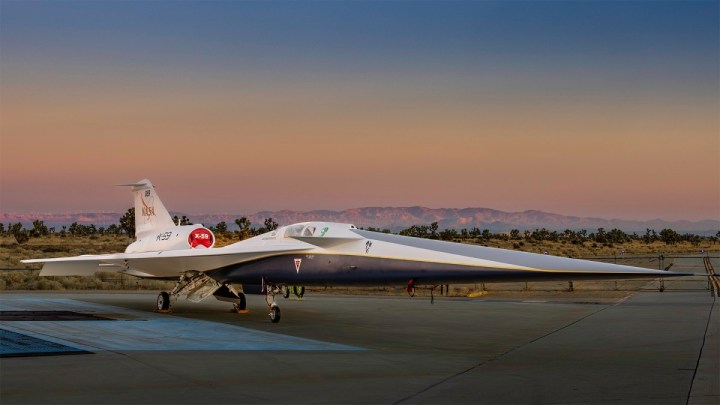NASA has shown off its new quiet supersonic aircraft, the X-59. Created along with Lockheed Martin, the aircraft is designed to reduce the sonic boom created by traveling faster than the speed of sound to what the agency calls a “sonic thump.” Supersonic flights over land are currently forbidden due to the noise disturbance they cause, and the X-59 is an experimental aircraft aimed at reducing this noise to something more tolerable to those on the ground.
At an event today, Friday January 12, NASA debuted the aircraft ahead of testing. Its first flight is scheduled for later this year. In a statement, NASA said that it aims to use this one-of-a-kind airplane to gather data and pave the way for future commercial supersonic aircraft.

“This is a major accomplishment made possible only through the hard work and ingenuity from NASA and the entire X-59 team,” said NASA Deputy Administrator Pam Melroy. “In just a few short years ,we’ve gone from an ambitious concept to reality. NASA’s X-59 will help change the way we travel, bringing us closer together in much less time.”
NASA also showed off the new aircraft in a video, which has little information, but lots of gorgeous shots of the striking craft sitting on the runway:
Once integrated systems testing, engine runs, and taxi testing of the aircraft are all complete, it will be used in test flights that aim to see how people on the ground respond to the reduced noise of its sonic thump as it flies overhead, compared to a sonic boom. If the public finds the noise tolerable, that could help to persuade regulators to allow some supersonic flights over land. That’s the goal of NASA’s Quesst mission, of which the X-59 experimental aircraft is a part.
“It’s thrilling to consider the level of ambition behind Quesst and its potential benefits,” said Bob Pearce, associate administrator for aeronautics research at NASA Headquarters. “NASA will share the data and technology we generate from this one-of-a-kind mission with regulators and with industry. By demonstrating the possibility of quiet commercial supersonic travel over land, we seek to open new commercial markets for U.S. companies and benefit travelers around the world.”
The X-59 has been in development since 2016, and can fly at speeds of up to 925 mph, or Mach 1.4. It is just shy of 100 feet long and has an elongated shape that is designed to prevent shock waves created by supersonic flight from merging, which will help reduce their volume.
Editors’ Recommendations
Services Marketplace – Listings, Bookings & Reviews